How to fish the Top Pool on the Welsh Dee at Llangollen
Table of Contents
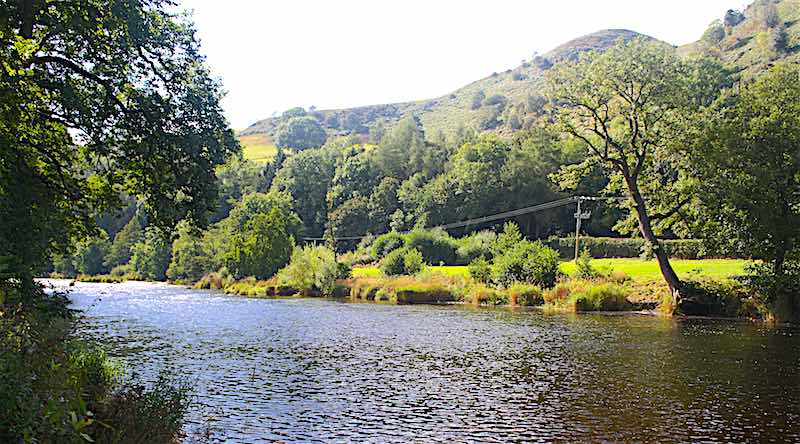
The Top Pool is the upper limit of Llangollen AA upper beat of the Welsh Dee, which can be fished on a day ticket. It holds a good head of trout and grayling, and when in season, it is a good salmon and sea trout pool.
At river levels up to ca. 0.7 m (Corwen gauge) the Top Pool is a great place for fly fishing. At levels above 0.7 m, it is too deep wade and you are restricted to fishing from the bank, which is not easy because of bankside vegetation and bushes.
It is accessed by walking upriver from the Fridge Pool, through the wooded area. The walk through the wood can be difficult, especially when trees have fallen, so take extra care. That said, the fishing there is generally worth the effort because not many anglers venture that far upriver.
Next, how to fish the Top Pool for grayling.
Fishing the Top Pool for trout and grayling
The Top pool has produced some spectacular catches of grayling for me over the years. Especially when fishing between February and November.
I enjoy fishing this pool for trout and grayling when the river level is below 0.65m (Corwen). At higher levels, it’s necessary to fish the pool from the bank, which is difficult because the steep wooded bank inhibits your backcast.
To get the best fishing results I divide the Top Pool into three sections…
Approach it as three pools in one!
The Welsh Dee flows almost due north through the Pipe Pool and is flanked on the east and west by steep hills.
In summer, the pool is in the shade until 11 am, after which it receives the suns full glare until about 7 pm. However, during the winter months, the sun only hits the pool for an hour or so at about 1 pm.
I’ve made the following sketch to show you where I normally catch trout and grayling in each of the sections.
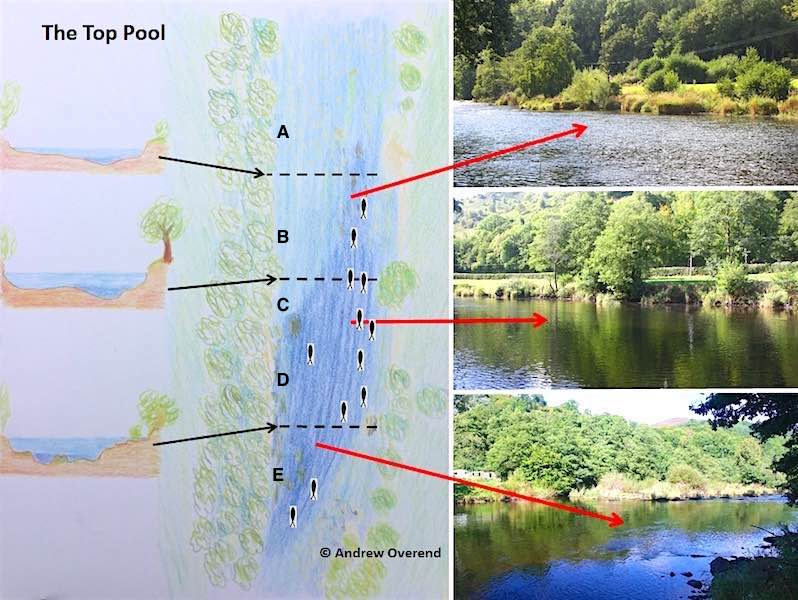
How to fish the Top Pool - Riffle section & Drop-off zone
Often the most productive section of the Top Pool for catching trout and grayling is between points C and A when the river is at its summer level (0.55 m Corwen gauge).
Trout tend to lie close to the rock and weed beds close to the far bank. Grayling, on the other hand, are caught across the full width of the river. The large grayling, however, are caught downstream of the submerged boulders near the far bank.
So, how do I approach fishing this section of the pool…
Not surprisingly, it depends on both the river conditions at time of year.
Clear Water conditions:
If no flies hatching in early spring, I will begin by fishing a team of nymphs. Using the short-range nymphing technique, I start fishing at point C and work my way across the river as far as possible. Then I fish back to the near bank so that I’m one rod-length further upstream of where I started.
This zig-zag upstream process is repeated until I reach point A.
Grayling and trout are normally caught in the slacker pocket of water in the main flow using the short-range nymphing method. The following team of nymphs usually work well early in the season on the Welsh Dee.
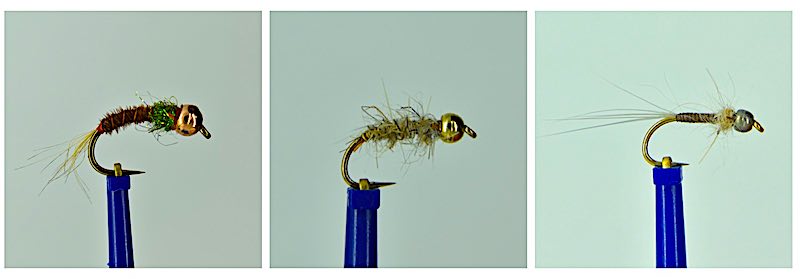
Small nymphs (size 14 -18) teamed with a heavy point fly tend to produce the best results. The heavy point fly is used to get small nymphs to the river bed quickly.
The following video show how to fish the Top Pool with a team of nymphs when the river is close to its summer level
Wet Fly and Spider fly fishing:
Hopefully, the will be a fly hatch at some point during the day, and the fish will start to take flies near or at the surface. When this happens, switching to fishing a team of wet-flies and/or spiders is often a good move.
Again, it is best to fish the wet flies and/or spider up and across, starting at point C and working up to point A. Covering all the water out to the main channel.
Cast the flies upstream at a 45o angle, allow them to drift drag-free downriver. Mend the line upstream regularly to stops the flies swinging around too fast. Often…
takes come immediately after the upstream mend.
After reaching point A, I find it productive to fish the slacker water between the main channel and the far bank by casting the flies across the river and letting the main current pull the flies around in an arc.
This across and down approach catches the trout and grayling lying close to the far bank, which are difficult to cover by fishing upriver.
Takes are often violent…
Therefore, it’s best to hold the rod up at a 20-degree angle to absorb the shock of the take.
The following image show one of my default early season team wet flies / nymphs that work well on the Welsh Dee:
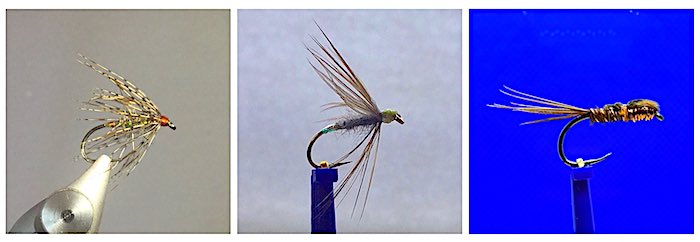
The following video show how to fish the Top Pool with a team of wet flies / spiders when the river is close to its summer level
Dry fly Fishing:
There’s no finer sport than dry fly fishing and it’s my preferred approach when fish are taking flies at the surface.
It is best to fish the dry flies up and across, starting at point C and working up to point A. Targeting all the rising fish while working upriver.
Ideally, it’s best to try and identify the flies that are being taken and tie on a suitable imitation. To help with this check out this mobile-friendly digital…
If that is not possible, I usually start with a Jingle that has served me well, and if that doesn’t work I start working through my fly box. However, it’s rare not to catch early season trout and/or grayling on one of the three following patterns:
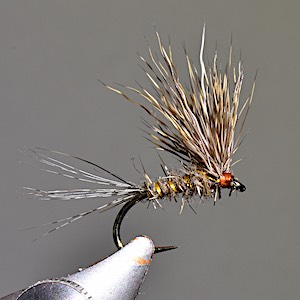
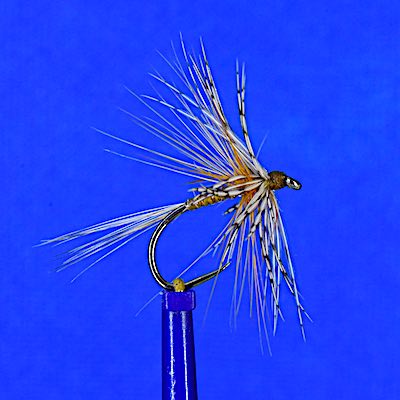
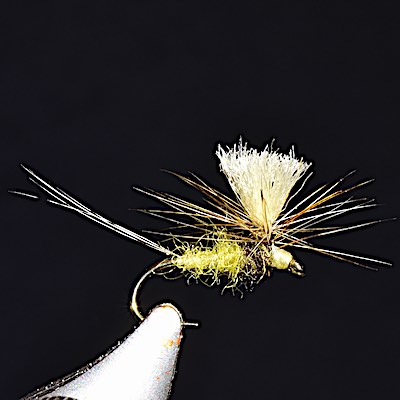
Fly fishing in coloured water
When the river is carrying some colour then I find it is best to start with a team of colourful Czech nymphs. Under these conditions, search the river bed in a zig-zag pattern from point (A) to point (C). Note, grayling can be caught even in the shallow water close to the bank.
A section of Czech nymphs that work well when the river is coloured is shown below.

If you see flies hatching and your catch rate falls with the Czech nymphs, then a switch to wet flies or dry flies can often yield good results.
How to fish the Top Pool - middle, deep run section
Wet fly fishing:
I find the middle of the pool, point (C) to (D) is best tackled with either a team of wet flies/spiders or the dry fly because this section of the pool has to be fished from the bank.
My approach to fishing the wet flies is to cast them straight across the river and let them drift drag-free downriver. Adding small upstream into the line to slow the swing of the flies (c.a. after every 2 metres of drift).
Often takes occur after mending the fly line.
When the flies reach the dangle, I use a slow ‘figure of eight’ retrieve a few metres of the fly line before recasting. This step will pick up the odd bonus fish.
Ensure you hold the rod tip is at least 2ft above the water because it provides some slackline to help securely hook the fish in the side of its mouth.
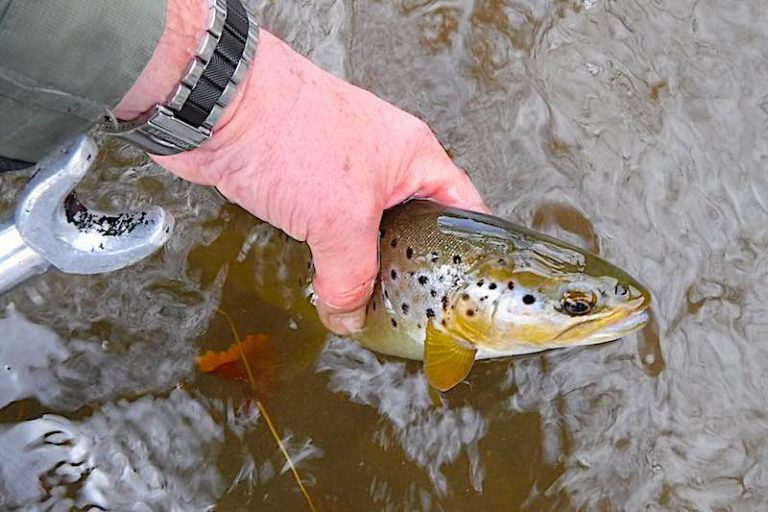
Dry fly fishing:
When fish are rising in the middle section, I will start fishing with the dry fly at point (D).
Instead of casting directly to the rising fish close to the far bank, I will cover the zone between the near bank and the rising fish with a couple of casts. This often produces a bonus fish that wasn’t spotted rising.
How to fish the Top Pool - The tail:
The pool tail (E to D) is difficult to fish past the middle of the river because bankside vegetation hinders your backcast. Unless you are good at distance roll casting.
I find fishing the tail with wet & dry fly techniques produces good results. When the river is low during the summer make sure you fish all the way into the V of the tail. Especially on warm summer evenings.
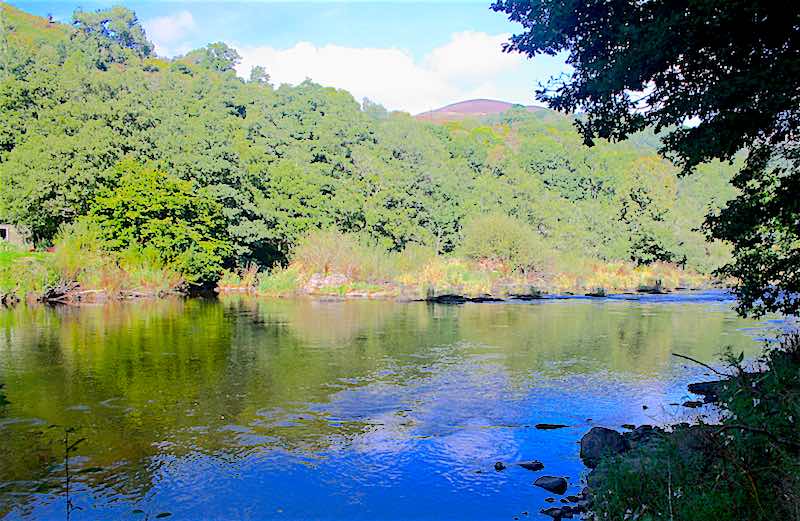
How to fish the Top Pool
Unless you are confident at deep wading fish the tail of the pool from the bank.
Occasionally, I have waded down through this section of the river is below 0.5m (Corwen gauge) to cover the fish closer to the far bank. However, wading here is not for the faint-hearted because it is deep and the riverbed is littered with slippy rock outcrops and obstacles on the riverbed.
Trout & grayling fly fishing round-up:
October to April
Largely my approach depends on the water and air temperatures.
On cold days Czech nymphs work well, particularly when there’s little to no surface fly activity.
When flies are hatching dry fishing can yield good results.
However, I find wet flies, spiders and nymphs fished close to the surface out fish dries.
May to September
My approach is governed by the time of day and cloud cover.
Early in the morning wet flies, spiders & nymphing techniques work well, followed by dry flies.
On bright sunny days, by mid-day onwards focus on searching the bottom of well-oxygenated, shady runs with Czech nymphs.
In the evening dry flies and wet flies fished close to the surface usually pay dividends.
Additional reading - Welsh Dee trout and grayling fly selection
If you are interested in learning more about the various flies that I find work on the Welsh Dee throughout the year then it’s worth reading the following post:
- 10 grayling flies for January
- Best grayling flies for February
- 10 Trout flies for March
- 6 April flies for catching more trout
- 11 top trout fly patterns for May
- 8 Great flies for June on the Welsh Dee
- 8 flies for July on the Welsh Dee
- Best trout flies for August
- 12 great flies for September
- 10 grayling flies for October
- Best grayling flies for November
- 13 grayling flies for December
How to fish the Top Pool for salmon:
The Top Pool is a good place to fish with the salmon fly, especially when the river level is below 0.7m (Corwen gauge).
At higher levels wading becomes treacherous and it is difficult to fish from the bank with the fly. Therefore, fishing becomes restricted to spinning from the bank.
Over the years, I have hooked three salmon in this pool on the fly, all from August onwards, but not managed to land any of them. Two of the fish threw the hook while leaping in the air. One salmon took a Sliver Stoats Tail (size 10 double) and the other a Curry’s Red Shrimp (size 12 double); both on a floating line.
The third fish took a Silver Sedge while fishing for trout and I just couldn’t get it in the net with the 3lb leader I was using.
From experience and talking to fellow anglers the sketch below highlights where best to find salmon within this pool.
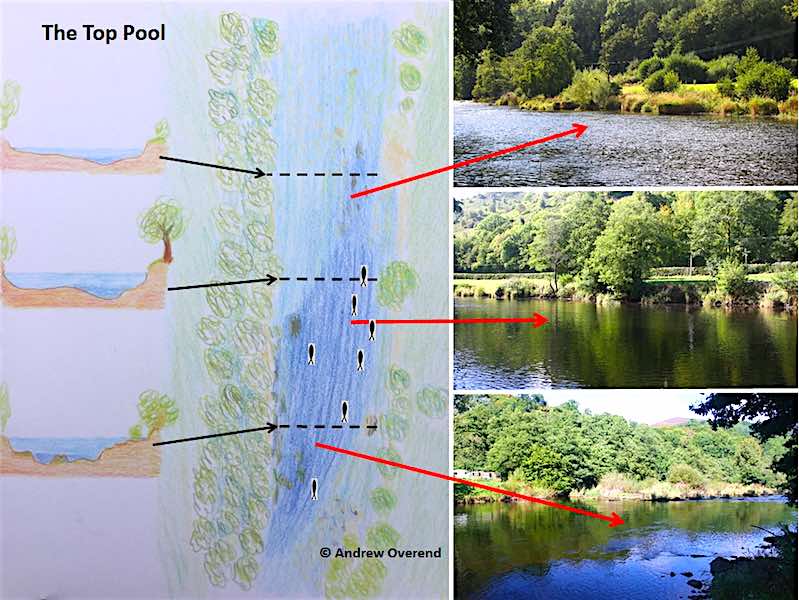
I mainly fish this pool with the fly from July to September because this is typical when the river level below 0.7m.
Most of this pool is less than 5ft deep; therefore, I normally use either a floating line with a 12ft copolymer tapered leader; or a 7ft sinking polyleader tipped with 4ft of 15lb fluorocarbon when I need to fish a couple of feet down in the water column.
For fly selection, I use this simple strategy on how to fish the top pool for salmon
In coloured water a higher brightly coloured fly e.g. Cascade, Park shrimp, etc.

In clear water use drab coloured fly e.g. Stoats tail, Blue Charm, etc.
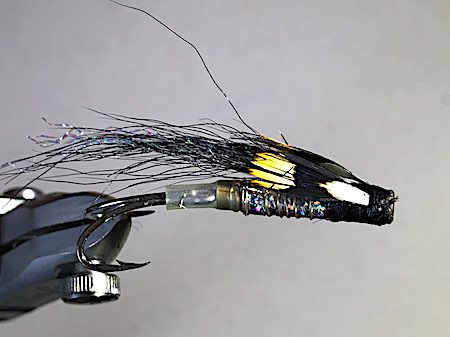
Rather than spending time agonizing over which fly to use, I have found it is more important to focus your attention on locating where the salmon are lying and how best to cover them such that they take what you’re offering.
In addition, I’m of the opinion that salmon are either interested in taking or not because the majority of salmon I have caught on the Welsh Dee has been on the first run through the pool.
As such, I now tend to fish pools quickly and then move on to the next one with the aim of covering as much of the river as possible. A side benefit of this strategy is that you get plenty of exercise, which keeps you fit!!!
In the last few years, during the summer months, I now prefer flies dressed on single hooks (size 6 to 10) fished on a 10ft 6# reservoir trout rod. My reasoning is that during the summer there are not many salmon in the Welsh Dee and I don’t like carrying extra gear when my focus is on trout and grayling for most of the day.
This approach means I only have to carry an extra small fly box containing a few small salmon flies. Thus, allowing me the opportunity to run through likely lies during the last hour before sunset, which is probably the best time to tempt a salmon.
In addition, it keeps me occupied until nightfall and my final switch to targeting sea trout.
Fishing the Top Pool for Sea Trout
Until recently I have not fished for sea trout in the Top Pool after dark, because it is not easy to follow the path back through the wood at night.
However, in the last couple of years, I have made the effort and this has produced some success. The following sketch shows were I have caught sea trout to-date.
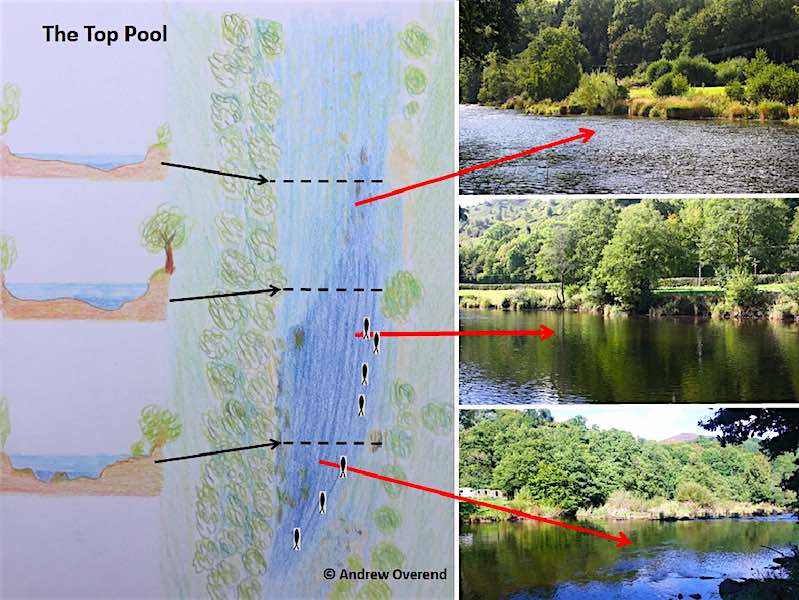
During the day sea trout tend to lie close to the far bank, along the ledge, in the shadow of the bank-side trees. They are tempted with small wet flies (e.g. Peter Ross, Black Pennell etc. sizes 10 to 14), fished on a floating line tipped with a slow sinking polyleader and 5ft of 5-6lb fluorocarbon.
When the river is running off after a summer spate (0.6m and lower Corwen gauge), cast the flies square across the river and then strip them back with short pulls after every meter of downstream drift.
Takes are often violent…
Therefore, be prepared to let them take some line. Otherwise, you will be broken. This technique works well from just above the large tree on the far bank down to the rock outcrop.
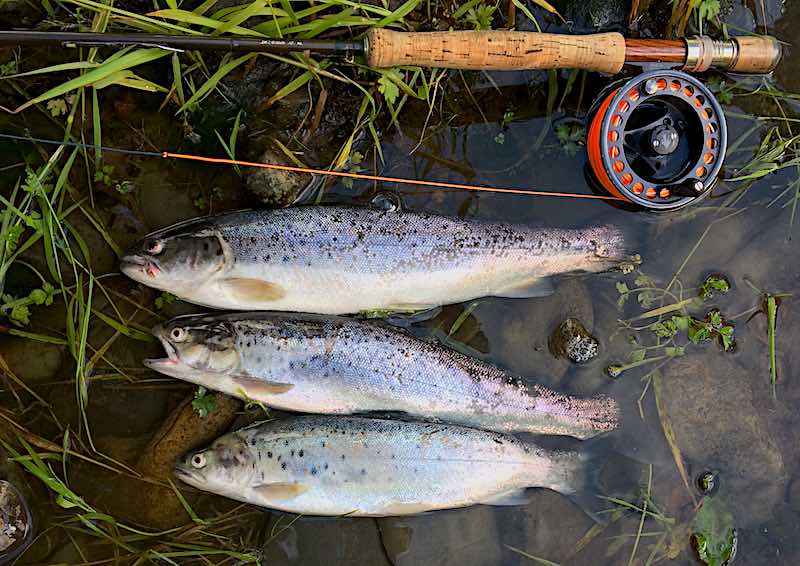

In the evening as the light fades, I start fishing the fast riffle with a team of small wet flies (size 14 -12) on a floating line tipped with an intermediate polyleader and 5ft of 6lb fluorocarbon.
This approach usually produces sea trout in the 1 to 3lbs bracket. In addition, you will are likely to catch a large brown trout or large grayling to a couple of pounds.
At nightfall, I change the tippet to 10lb copolymer and then work my way down through the body of the pool with a slightly large point fly and a smaller fly on the dropper.
When I reach point C I get out and move downriver to fish the tail from the safety of the bank, because the fish lie behind the ledges/rocks close to the bank.
In addition, the tail is treacherous to wade and I don’t fancy getting washed into the rapid section night!!!!
How to fish the top pool for sea trout.
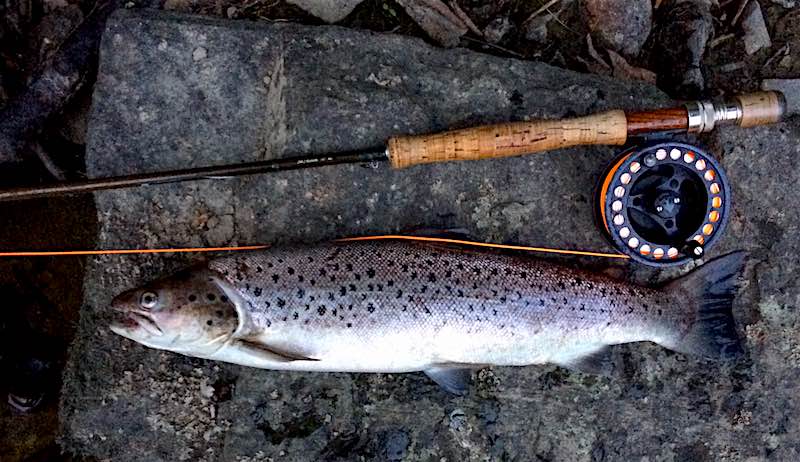
If I don’t get any takes on the first run through the pool, I change to a slow sinking polyleader and a heavier fly. Then, rest the pool for 20 minutes before fishing through it again.
If this doesn’t work then I move downriver to another pool; usually Dee Farm.
Where do I get day tickets?
The Top Pool is part of Llangollen-Maelor Upper beat and day tickets for visiting anglers can be obtained by visiting the club website (Tariffs).
If further information is required, please click here to contact the club, who will be more than happy to help you.
Directions and Parking
From Llangollen take the A5 to Crown then just after the junction with the B5103 by Berwyn Station take the next right and follow the lane for about 1mile. At the end of the lane, you will see the top car park on your left.
Walk up the lane from the car park to the style that takes you into the field on your right. Follow the fence down the hill to the river and then walk upriver and through the gate that takes you into the wood. The walk through the wood can be difficult, especially when trees have fallen, so take extra care.
[Disclaimer – like most outdoor sports, fishing is not without its hazards. Therefore, you MUST do your own RISK ASSESSMENT before starting to fish; especially if you decide to wade and/or fish at night. In addition, you must follow the club rules when fishing this water.] How to fish the top pool directions.
How to fish the Top Pool